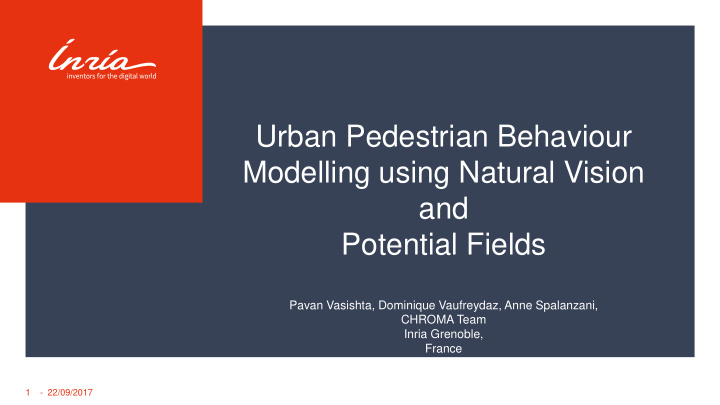



Urban Pedestrian Behaviour Modelling using Natural Vision and Potential Fields Pavan Vasishta, Dominique Vaufreydaz, Anne Spalanzani, CHROMA Team Inria Grenoble, France 1 - 22/09/2017
P.Vasishta, D. Vaufreydaz, A.Spalanzani, Inria Grenoble, France Why do we need this? Increasing situational awareness on an urban street – getting to level 3 2 - 22/09/2017
P.Vasishta, D. Vaufreydaz, A.Spalanzani, Inria Grenoble, France Natural Vision? Natural Vision – “..human behaviour in wanting to move in a direction that interests them the most in their field of view … ” [3] Pedestrian behaviour is a function of the built environment made up of positive and negative attractors Points of Interest (POI) – “…Monuments, places of public interest, public transportation…stores, restaurants, etc…” [3] 3 - 22/09/2017
P.Vasishta, D. Vaufreydaz, A.Spalanzani, Inria Grenoble, France How do we model this? 3D representation of a scene Potential fields [4] In a structured urban environment, for legal crossings to occur, certain assumptions are made: > The edges of the road repel pedestrians. > A cross-walk acts as a conduit between the two sides of the street > The road acts as a barrier for crossing, repelling pedestrians towards the side-walks. > Static and Dynamic obstacles in the scene are repulsive in nature. > Side-walks offer no resistance to pedestrian movement. > Points of Interest are a reason for pedestrians to cross 4 - 22/09/2017
P.Vasishta, D. Vaufreydaz, A.Spalanzani, Inria Grenoble, France Dataset Used for Testing Scene from the Dataset Activity modeling and abnormality detection dataset [6] Contains Points of Interest at (1), (2), (3) and (4) Dynamic obstacles in the form of cars and bicycles Captures pedestrian movement 5 - 22/09/2017
P.Vasishta, D. Vaufreydaz, A.Spalanzani, Inria Grenoble, France Results 6 - 22/09/2017
P.Vasishta, D. Vaufreydaz, A.Spalanzani, Inria Grenoble, France Problems it will help solve Recognizing danger areas in the observed scene Better prediction of pedestrian behaviour Illegal pedestrian crossings 7 - 22/09/2017
P.Vasishta, D. Vaufreydaz, A.Spalanzani, Inria Grenoble, France For more information… Come see my poster References: [1] M. R. Endsley , “Toward a theory of situation awareness in dynamic systems ,” Human Factors: The Journal of the Human Factors and Ergonomics Society , vol. 37, no. 1, pp. 32 – 64, 1995. [2] B. Hillier, A. Penn, J. Hanson, T. Grajewski , and J. Xu, “Natural movement: or, configuration and attraction in urban pedestrian movement ,” Environment and Planning B: planning and design , vol. 20, no. 1, pp. 29 – 66, 1993. [3] J. J. Gibson, “The ecological approach to visual perception.” 1979 [4] M. T. Wolf and J. W. Burdick, "Artificial potential functions for highway driving with collision avoidance," 2008 IEEE International Conference on Robotics and Automation , Pasadena, CA, 2008, pp. 3731-3736. [5] P. Vasishta, D. Vaufreydaz, A. Spalanzani , “ Natural Vision Based Method for Predicting Pedestrian Behaviour in Urban Environments”, IEEE 20 th International Conference on Intelligent Transportation Systems, Yokohama, Japan, 2017. [6] J. Varadarajan and J-M. Odobez , “Topic models for scene analysis and abnormality detection”, 2009 IEEE12 th International Conference on Computer Vision (ICCV Workshops), 2009 8 - 22/09/2017
Recommend
More recommend